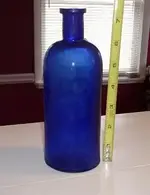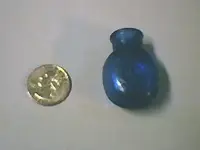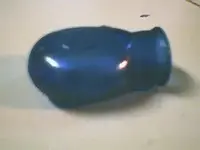Darren in NC
Silver Member
- Joined
- Apr 1, 2004
- Messages
- 2,829
- Reaction score
- 1,709
- Golden Thread
- 0
- Detector(s) used
- Tesoro Sand Shark, Homebuilt pulse loop
- Primary Interest:
- Shipwrecks
- #21
Thread Owner
Re: If you care to believe...
Charles, I got some good advice from Eric Foster on the coil. But I used Gary's analog plans for the control box (his website is listed below). I didn't want to program PICs, so I went with his simple analog design.
Giterdone, I've had a lot of request for this unit, so I'm posting the long details here...
All the info and diagragms you need for the control box are at:
http://www3.telus.net/chemelec/Projects/Metal-2/Metal-2.htm
The large 1 meter coil is as follows:
Claude on Geotech Forum built a 1m coil with the GoldPic ? He said: (I used a multi-wire 12 wire multistrand 0.25 and I inserted then soldered between them the wires, leaving two for connection.) He says: I used a multi-wire because I wanted to keep intact the plastic tubes, so a regular coil made outside the tubes would not allow this. I bought a 12-wire non-screened cable, .22 multi-stranded of lenght 5 meters. I bought aluminium tape and put on all lenght of cable. I inserted cable in prepared tubes and 90?shoulders, then I soldered ends of 11 out of 12 wires (11 turn coil), to form a spiral, each wire with the next (see colors). I insulated, made an opening in the tube and soldered a regular LAN coax cable (75 ohm). That's all. Pay attention not to touch the aluminium insulation to form a circle, leave a portion unprotected. You can solder the coax shield also to one end of aluminium tape (difficult to solder). Attention not to leave too much wire, because
it will be difficult to close tubes, the multi-wire with alu tape on it
is not so flexible. Keep it as short as it allows you to solder.
Another 1 meter coil that's flexible:
Eric Foster wrote on the PI classroom forum: I made flexible (not inside a pvc square, but just loose to tie to any frame) coils for the Superscan PI detector that I used to make. The coils were made from 12 way cable with each conductor made up of 16/0.2 strands. The wires in the cable are all colour coded which makes connecting into a coil easy. Say I wanted to make a 1m square coil; I would then cut a 4m length of cable. The outer sheath would be stripped back a few cm. at each end to expose the individual conductors and their coloured sleeves. Take the red lead at one end as the start of the coil. Go to the other end and bend the cable around to give a circular coil initially. Strip the insulation off this second end of the red lead and join it to another colour wire at the start end, say yellow. Go to the far end of the yellow lead and join it to another colour at the start end, say orange. Continue this procedure, always joining to a new colour to avoid getting a shorted turn. Measure the inductance as you go and stop when the required figure is reached. Any unused conductors will have no effect. Each join should be sleeved with heat shrink to avoid shorts. I used to do all of this joining so that it was inside a plastic potting box (remember, it?s a flexible coil, but the joint is in the plastic box) and then take the coax cable out through a cable gland. The whole joint would be potted in epoxy to give a neat finish. The finished coil can be either a 1m square, 0.5 x 1.5m rectangular, or whatever you wanted.
Charles, I got some good advice from Eric Foster on the coil. But I used Gary's analog plans for the control box (his website is listed below). I didn't want to program PICs, so I went with his simple analog design.
Giterdone, I've had a lot of request for this unit, so I'm posting the long details here...
All the info and diagragms you need for the control box are at:
http://www3.telus.net/chemelec/Projects/Metal-2/Metal-2.htm
The large 1 meter coil is as follows:
Claude on Geotech Forum built a 1m coil with the GoldPic ? He said: (I used a multi-wire 12 wire multistrand 0.25 and I inserted then soldered between them the wires, leaving two for connection.) He says: I used a multi-wire because I wanted to keep intact the plastic tubes, so a regular coil made outside the tubes would not allow this. I bought a 12-wire non-screened cable, .22 multi-stranded of lenght 5 meters. I bought aluminium tape and put on all lenght of cable. I inserted cable in prepared tubes and 90?shoulders, then I soldered ends of 11 out of 12 wires (11 turn coil), to form a spiral, each wire with the next (see colors). I insulated, made an opening in the tube and soldered a regular LAN coax cable (75 ohm). That's all. Pay attention not to touch the aluminium insulation to form a circle, leave a portion unprotected. You can solder the coax shield also to one end of aluminium tape (difficult to solder). Attention not to leave too much wire, because
it will be difficult to close tubes, the multi-wire with alu tape on it
is not so flexible. Keep it as short as it allows you to solder.
Another 1 meter coil that's flexible:
Eric Foster wrote on the PI classroom forum: I made flexible (not inside a pvc square, but just loose to tie to any frame) coils for the Superscan PI detector that I used to make. The coils were made from 12 way cable with each conductor made up of 16/0.2 strands. The wires in the cable are all colour coded which makes connecting into a coil easy. Say I wanted to make a 1m square coil; I would then cut a 4m length of cable. The outer sheath would be stripped back a few cm. at each end to expose the individual conductors and their coloured sleeves. Take the red lead at one end as the start of the coil. Go to the other end and bend the cable around to give a circular coil initially. Strip the insulation off this second end of the red lead and join it to another colour wire at the start end, say yellow. Go to the far end of the yellow lead and join it to another colour at the start end, say orange. Continue this procedure, always joining to a new colour to avoid getting a shorted turn. Measure the inductance as you go and stop when the required figure is reached. Any unused conductors will have no effect. Each join should be sleeved with heat shrink to avoid shorts. I used to do all of this joining so that it was inside a plastic potting box (remember, it?s a flexible coil, but the joint is in the plastic box) and then take the coax cable out through a cable gland. The whole joint would be potted in epoxy to give a neat finish. The finished coil can be either a 1m square, 0.5 x 1.5m rectangular, or whatever you wanted.






 Darren.Your a man who loves the excitment of the hunt with little or no monetary gain.Good for you.Well not that its not nice, But the excitment is what its all abought.You have a good friend,Iwould have got my own detector,We all know how the kinfolk come out of the wood work after the work is done.Looks like a good story for the cold weather ahead.Best of luck and HH.
Darren.Your a man who loves the excitment of the hunt with little or no monetary gain.Good for you.Well not that its not nice, But the excitment is what its all abought.You have a good friend,Iwould have got my own detector,We all know how the kinfolk come out of the wood work after the work is done.Looks like a good story for the cold weather ahead.Best of luck and HH.